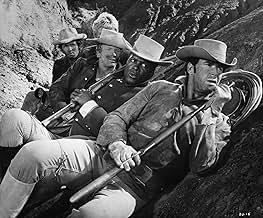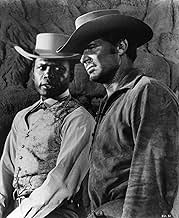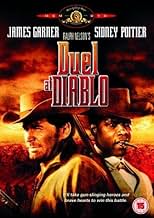CALIFICACIÓN DE IMDb
6.5/10
4.7 k
TU CALIFICACIÓN
En territorio apache, un hombre busca al asesino de su mujer india y una ama de casa abandona a su marido, para unirse a la tribu de su amante apache.En territorio apache, un hombre busca al asesino de su mujer india y una ama de casa abandona a su marido, para unirse a la tribu de su amante apache.En territorio apache, un hombre busca al asesino de su mujer india y una ama de casa abandona a su marido, para unirse a la tribu de su amante apache.
- Dirección
- Guionistas
- Elenco
- Premios
- 1 nominación en total
Ralph Nelson
- Col. Foster
- (as Alf Elson)
Armand Alzamora
- Ramirez
- (sin créditos)
Ralph Bahnsen
- Trooper Nyles
- (sin créditos)
Timothy Carey
- Deputy Clem
- (sin créditos)
Jeff Cooper
- Trooper Casey
- (sin créditos)
Kevin Coughlin
- Norton
- (sin créditos)
Robert Crawford Jr.
- Trooper Swenson - Bugler
- (sin créditos)
Opiniones destacadas
James Garner is a good lead in this rousing Cavalry v. Indians western. There are very good battle scenes between between the outnumbered soldiers and the attacking Indians. The underlying issues of prejudice add an interesting touch to the movie as well with James Garner's character struggling with the death of his Indian wife and the Bibi Andersson character struggling with raising her baby fathered by an Indian brave.
As in any good western, the scenery also plays an important part and the southern Utah settings are particularly striking. The musical soundtrack is a little off-beat for a western, but also very good. Dennis Weaver, Sidney Poitier, and Bill Travers all add to the movie with good supporting performances.
As in any good western, the scenery also plays an important part and the southern Utah settings are particularly striking. The musical soundtrack is a little off-beat for a western, but also very good. Dennis Weaver, Sidney Poitier, and Bill Travers all add to the movie with good supporting performances.
Lieutenant McAllister and a raw recruit of soldiers have to travel through Apache territory to deliver some much need ammunition to the awaiting Fort Conchos. Scout Jess Remsberg tags along with revenge on mind and horse broker / former trooper Toller who unwillingly receives an order to ride with them to finish off breaking the horses, if he wants the rest of his money. However McAllister and his small party find themselves trying to survive an Apache onslaught led by Chata, as the lady Ellen Grange that Jess rescued from the Apaches has something of importance to the chief.
A competently well-made and satisfying western that's highlighted by the prominent cast and exhilaratingly taut and unsparing action sequences. Ralph Nelson smoothly paces this drum-beating foray, with its adeptly bold and old-fashioned direction. His professional touch lifts the screenplay. Going a long way to giving it a real bravado feel amongst the gritty, dusty and sprawling rocky terrain, which is masterfully framed with a lot of ticker and claustrophobic channelling by cinematography Charles F. Wheeler. The main feature of the film that strikes a chord, has got to be composer Neal Hefti's effectively novel, melodic score that seems to match and illustrate the sequences and overall feel rather well, despite the uncanny tone for this type of film. I found the dynamic cues to be rather contagious. Albert and Michael M. Grilikhes' open screenplay (which is based on the Marvin Albert's novel, "Apache Rising") is pretty much to the point and a little lacking by simply going through the motions. But even with those vague moments, it still thrives on well-rounded dialogues from its sturdy script. In there are configurations of racism, and the unfair treatment of the Indians, but it's the personal confrontations and torment that makes for one gruelling exercise. It never lets any of this get carried away, but the starkly harsh nature stays throughout. The performances are richly devised, to stew up depth and realism due more to their favourable acting than in the way of the material. James Garner's winningly focused performance as rugged, seldom Jess is first-rate. Sidney Poitier classy turn as Toller is a different stroke and admirably good one. Bill Travers' growing performance is very strong and humane. Dennis Weaver eclectically solid. Bibi Andersson was mildly okay, but was hindered and the modest John Hoyt didn't see enough time as Chata.
Dated, but a well handled, compelling and tough as nails western, which finally shines through.
A competently well-made and satisfying western that's highlighted by the prominent cast and exhilaratingly taut and unsparing action sequences. Ralph Nelson smoothly paces this drum-beating foray, with its adeptly bold and old-fashioned direction. His professional touch lifts the screenplay. Going a long way to giving it a real bravado feel amongst the gritty, dusty and sprawling rocky terrain, which is masterfully framed with a lot of ticker and claustrophobic channelling by cinematography Charles F. Wheeler. The main feature of the film that strikes a chord, has got to be composer Neal Hefti's effectively novel, melodic score that seems to match and illustrate the sequences and overall feel rather well, despite the uncanny tone for this type of film. I found the dynamic cues to be rather contagious. Albert and Michael M. Grilikhes' open screenplay (which is based on the Marvin Albert's novel, "Apache Rising") is pretty much to the point and a little lacking by simply going through the motions. But even with those vague moments, it still thrives on well-rounded dialogues from its sturdy script. In there are configurations of racism, and the unfair treatment of the Indians, but it's the personal confrontations and torment that makes for one gruelling exercise. It never lets any of this get carried away, but the starkly harsh nature stays throughout. The performances are richly devised, to stew up depth and realism due more to their favourable acting than in the way of the material. James Garner's winningly focused performance as rugged, seldom Jess is first-rate. Sidney Poitier classy turn as Toller is a different stroke and admirably good one. Bill Travers' growing performance is very strong and humane. Dennis Weaver eclectically solid. Bibi Andersson was mildly okay, but was hindered and the modest John Hoyt didn't see enough time as Chata.
Dated, but a well handled, compelling and tough as nails western, which finally shines through.
Like the other reviewer of this movie, I, too, was a young child when I first saw this movie. It was around 1975 and it made quite an impression on me. My father, Bob Weissman, who loved the music in the film, first played the soundtrack for me. It is hypnotic and stirring -just excellent. The movie's storyline is not intricate, but what it lacks in depth, it makes up for with some suspense, good cinematography and of course, great music. James Garner is charismatic just like he is in "Support Your Local Sheriff" and Sydney Poitier, Dennis Weaver and Bibi Anderson fill their roles adequately. Overall, a good rental for a rainy (or snowy) afternoon or evening.
"Duel at Diablo" filmed in 1966, has a cast of both American and international players and touches of violence coupled with prejudices. It makes for an interesting mix and provides the viewer with a tense depiction of the usual struggles of the Apaches against the US Cavalry. James Garner plays Jess Remsberg, an Indian scout now out looking for the man or men that raped and killed his Indian wife. Sidney Poitier adds an excellent portrayal of a former Army sergeant who has quit the job of soldering in exchange for breaking horses, and selling them to the Army. Bill Travers and Bibi Anderson provide the international flavor in the cast, and Dennis Weaver gives the viewer a chance both to detest him and feel some sorrow for his warped prejudices toward those he considers inferior or below his status.
The group of troopers heads out across the desert to another fort in the area, but are headed off by a group of Apaches that have jumped their reservation. Garner does find out the identity of the man who was responsible for the rape/killing of his Indian wife, but in order to extract his revenge, he must first make it to the canyon of Diablo and rescue the beseiged group of Army troopers from being killed by the Apaches.
Good, tense story, sweeping vistas of the Utah landscape, and two actors, Garner and Poitier, delivering masterful performances.
The group of troopers heads out across the desert to another fort in the area, but are headed off by a group of Apaches that have jumped their reservation. Garner does find out the identity of the man who was responsible for the rape/killing of his Indian wife, but in order to extract his revenge, he must first make it to the canyon of Diablo and rescue the beseiged group of Army troopers from being killed by the Apaches.
Good, tense story, sweeping vistas of the Utah landscape, and two actors, Garner and Poitier, delivering masterful performances.
A bloody, brutal Western where the action never stops.
First, the Bad (let's get that out of the way). Like all Westerns, the plot has its flaws -- with an Indian war party off the reservation they would not have sent a shipment of ammunition through a narrow canyon guarded by only one squad of green recruits on unbroken/partly saddle broken horses. But so what? In the classic Western Stagecoach the Indians would have shot the horses pulling the stage and then finished off the passengers as opposed to shooting at the people in the coach. Also, Sidney Poitier's silver vest remains immaculate throughout the long desert journey and several pitched battles.
However, the movie moves so fast that you never really have time to stop and remind yourself that you have to "suspend disbelief" to watch it.
Next, the Good. On one level, it's a classic cavalry vs. Indians story. But viewed through a different lens than in earlier Westerns; the Indians are shown with some perspective, if not total sympathy, which probably makes this one of the first Westerns to get beyond a one dimensional view of them. There are a variety of interesting subplots which flesh out the major characters and keep things twisting, turning, and moving along between the combat scenes. In fact, almost every one of the characters is angry about something, creating lots of tension between them. James Garner's character is looking for the men who raped and killed his (Indian) wife, Dennis Weaver's Will Grange is angry about almost everything, including that his wife was held captive by the Indians, Sidney Poitier's Toller (now a civilian) is mad that circumstances forced him to accompany the cavalry on this mission ....
Garner and Poitier give excellent performances and the other actors rise to the occasion, helping us forget that they are, in fact, Scottish or Danish.
At the end of the movie the various subplots are tied up and the issues are resolved with (in one case) a very surprising twist.
On top of that, you have a wonderful (almost superb, for this movie) Neal Hefti score, which always seems to correctly reflect the mood of the scene. It fits the movie even better because it makes heavy use of Western/military instruments: guitars, horns, drums, ....
Finally, the Ugly. There are some fairly graphic scenes here (although not exactly like in the Wild Bunch or Saving Private Ryan). The Apaches could torture with the best of them and some of that appears in this movie, although we're spared the close-ups.
All in all, I must say that this is one of my long time favorites. I hope you enjoy it as much as I do!!
First, the Bad (let's get that out of the way). Like all Westerns, the plot has its flaws -- with an Indian war party off the reservation they would not have sent a shipment of ammunition through a narrow canyon guarded by only one squad of green recruits on unbroken/partly saddle broken horses. But so what? In the classic Western Stagecoach the Indians would have shot the horses pulling the stage and then finished off the passengers as opposed to shooting at the people in the coach. Also, Sidney Poitier's silver vest remains immaculate throughout the long desert journey and several pitched battles.
However, the movie moves so fast that you never really have time to stop and remind yourself that you have to "suspend disbelief" to watch it.
Next, the Good. On one level, it's a classic cavalry vs. Indians story. But viewed through a different lens than in earlier Westerns; the Indians are shown with some perspective, if not total sympathy, which probably makes this one of the first Westerns to get beyond a one dimensional view of them. There are a variety of interesting subplots which flesh out the major characters and keep things twisting, turning, and moving along between the combat scenes. In fact, almost every one of the characters is angry about something, creating lots of tension between them. James Garner's character is looking for the men who raped and killed his (Indian) wife, Dennis Weaver's Will Grange is angry about almost everything, including that his wife was held captive by the Indians, Sidney Poitier's Toller (now a civilian) is mad that circumstances forced him to accompany the cavalry on this mission ....
Garner and Poitier give excellent performances and the other actors rise to the occasion, helping us forget that they are, in fact, Scottish or Danish.
At the end of the movie the various subplots are tied up and the issues are resolved with (in one case) a very surprising twist.
On top of that, you have a wonderful (almost superb, for this movie) Neal Hefti score, which always seems to correctly reflect the mood of the scene. It fits the movie even better because it makes heavy use of Western/military instruments: guitars, horns, drums, ....
Finally, the Ugly. There are some fairly graphic scenes here (although not exactly like in the Wild Bunch or Saving Private Ryan). The Apaches could torture with the best of them and some of that appears in this movie, although we're spared the close-ups.
All in all, I must say that this is one of my long time favorites. I hope you enjoy it as much as I do!!
¿Sabías que…?
- TriviaJames Garner's first western since leaving Maverick (1957) and Sidney Poitier's first theatrical western.
- ErroresAs Willard hands his wife a gun, he says there are two cartridges in gun. However, it can be seen that all six chambers are loaded.
Bullet noses can be seen in the chambers on the left side of the cylinder but a minute or so later, the right side is on camera and shows 3 empty chambers.
- Citas
Ellen Grange: They all think that any decent woman would prefer to die than live as an Apache squaw. Maybe they're right.
Jess Remsberg: Death comes soon enough. Anyone who hurries it is a damn fool.
- Créditos curiososThe United Artists logo is sliced off the screen with a bloody Calvary Saber, slicing an "X" across the screen, revealing the opening scene. At the end, the same saber slices the live picture away, as (sort of) a fade out.
- ConexionesFeatured in Across 110th Street (1972)
Selecciones populares
Inicia sesión para calificar y agrega a la lista de videos para obtener recomendaciones personalizadas
- How long is Duel at Diablo?Con tecnología de Alexa
Detalles
- Tiempo de ejecución1 hora 43 minutos
- Color
- Relación de aspecto
- 1.66 : 1
Contribuir a esta página
Sugiere una edición o agrega el contenido que falta





































